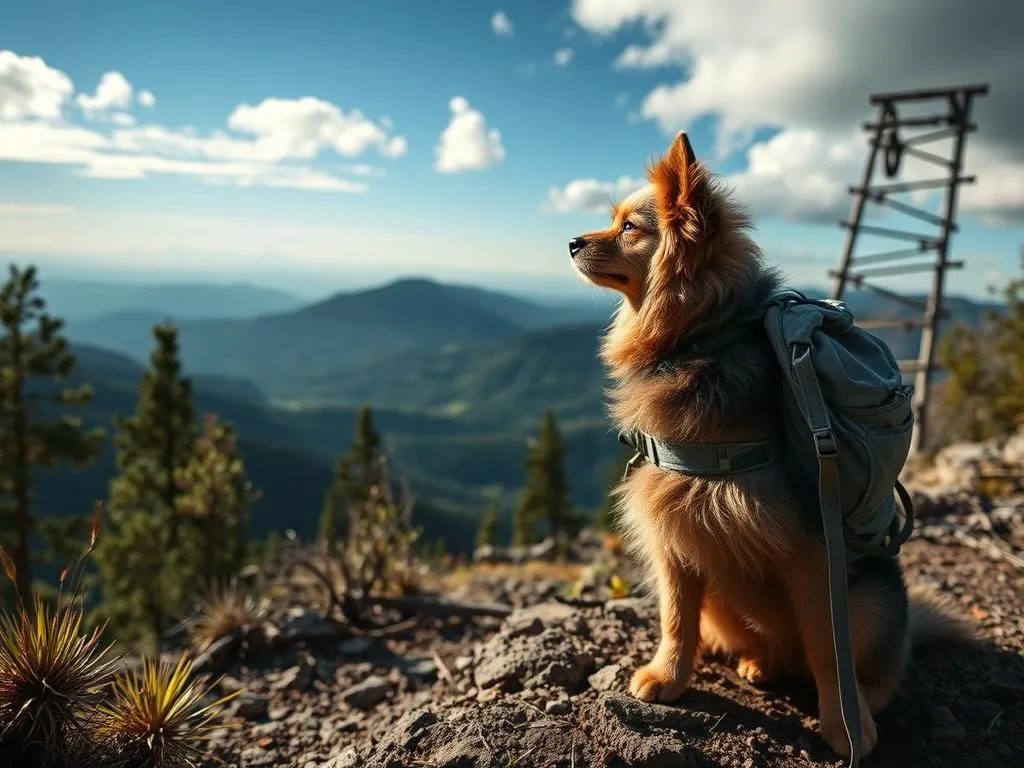
Introduction
Hiking with pets has surged in popularity, transforming from a niche activity into a beloved pastime for many outdoor enthusiasts. Small dogs, in particular, make delightful companions on the trail, bringing joy and energy to every adventure. However, hiking with small dogs requires extra consideration to ensure their safety and enjoyment. This article aims to provide practical tips for hiking with small dogs, allowing you to prepare for a fun and fulfilling outdoor experience.
Preparing for the Hike
Assessing Your Dog’s Health and Fitness Level
Before embarking on a hiking adventure, it’s crucial to perform a thorough assessment of your dog’s health and fitness level. A trip to the veterinarian for a check-up is essential, especially if your dog has any pre-existing health conditions. Discuss your hiking plans with your vet to ensure your dog is fit for the trek ahead.
Additionally, consider your dog’s activity level. Small dogs may have different energy levels and stamina compared to larger breeds. Evaluate how your dog performs on walks, and gauge their suitability for hiking based on their daily activity. If your dog is not accustomed to long walks, it may be wise to gradually increase their exercise before hitting the trails.
Choosing the Right Trail
Selecting the right trail is fundamental to a successful hike with small dogs. Consider factors such as difficulty level, terrain, and length. For small dogs, look for trails that are easy to moderate and have minimal steep inclines or rugged landscapes. Dog-friendly trails are often marked, and many parks have specific guidelines for pet owners.
Here are a few recommended types of trails for small dogs:
- Easy Trails: These trails often have a flat terrain, are well-maintained, and are generally short in distance.
- Moderate Trails: Slight elevation changes and some uneven paths might be appropriate for more active small dogs.
- Dog-Friendly Trails: Always check if a trail is dog-friendly, as some parks have restrictions on pets.
Gathering Essential Gear
Having the right gear can make a significant difference in your hiking experience. Here are some essential items to consider when preparing for your hike:
- Leashes and Harnesses: Opt for a sturdy yet lightweight leash and a comfortable harness designed for small dogs. A harness will help prevent strain on your dog’s neck and offer better control.
- Dog Backpacks: If your dog is fit and accustomed to carrying weight, consider a dog backpack for them to carry their own supplies, such as water and snacks.
- Hydration Gear: Bring along a collapsible water bowl and plenty of water to keep your small dog hydrated throughout the hike.
- First Aid Kits: A pet-specific first aid kit is crucial for addressing any minor injuries or emergencies that may arise during your adventure.
Safety Tips for Hiking with Small Dogs
Keeping Your Dog on Leash
One of the most important tips for hiking with small dogs is to keep them on a leash. Leash control is essential for maintaining safety, especially in areas with wildlife or steep cliffs. The right leash length can make a difference; a 6-foot leash is often ideal for maintaining proximity while allowing some freedom to explore. Retractable leashes can offer flexibility but should be used with caution.
Recognizing Signs of Fatigue or Distress
Small dogs can tire quickly, especially on longer hikes. Knowing the signs that your dog may need a break is crucial. Look for signs such as:
- Slowing down or lagging behind
- Panting excessively
- Seeking shade or resting in place
- Signs of distress, such as whining or excessive drooling
If you notice these signs, take a break. Provide fresh water and allow your dog to rest in a comfortable spot. Frequent hydration breaks are vital, especially on hot days.
Navigating Hazards on the Trail
The great outdoors can present various hazards. Be mindful of potential dangers that could affect your small dog:
- Wildlife: Small dogs can attract the attention of larger animals. Keep your dog close and be aware of your surroundings.
- Steep Cliffs and Rough Terrain: Always be cautious of steep drop-offs and rocky paths that may pose a risk to your dog’s safety.
- Overheating and Sunburn: Small dogs are particularly susceptible to overheating. Plan your hikes during cooler times of the day and consider dog-safe sunscreen for light-colored or short-haired breeds.
Essential Supplies to Bring
Hydration and Nutrition
Keeping your dog hydrated is critical while hiking. Pack enough water for both you and your dog, and plan for regular water breaks. Bring along a portable dog bowl or collapsible water container to make hydration easier.
When it comes to nutrition, consider bringing snacks that provide energy and are easy to digest. Some recommended snacks include:
- High-protein treats: Perfect for refueling.
- Dehydrated fruits: A healthy, energy-boosting snack.
- Commercially available dog trail mix: Specifically formulated for hiking dogs.
Comfort Items
Comfort is key for an enjoyable hike. Consider packing the following items:
- Dog Blankets or Pads: These can provide a comfortable resting place during breaks.
- Portable Dog Bowls: Ideal for keeping your dog hydrated without the mess.
- Collapsible Water Containers: Lightweight and easy to pack, these are convenient for on-the-go hydration.
First Aid for Dogs
A first aid kit designed for dogs can be a lifesaver in case of emergencies. Essential items to include are:
- Antiseptic wipes: For cleaning minor cuts or abrasions.
- Bandages: To wrap injuries and protect wounds.
- Tweezers: Useful for removing splinters or ticks.
- Dog-safe pain relief: Always consult your vet for recommendations.
Basic first aid procedures can include cleaning injuries, applying bandages, and monitoring your dog for any signs of distress.
Training Your Small Dog for Hiking
Basic Commands
Training your small dog in basic obedience commands is vital for a successful hiking experience. Commands like “sit,” “stay,” and “come” can help manage your dog in various situations. If you plan to hike in areas where it’s safe to let your dog off-leash, ensure they are well-trained and responsive to commands.
Gradual Conditioning
Just like humans, dogs need to build endurance for longer hikes. Gradually condition your dog by starting with shorter walks and increasing the distance over time. A few short practice hikes will help your dog acclimate to the activity.
Consider these steps for gradual conditioning:
- Start with short, easy walks: Gradually increase the distance and complexity.
- Incorporate different terrains: Expose your dog to various surfaces such as grass, dirt, and gravel.
- Increase duration: Slowly extend the time spent on each hike, allowing your dog to adjust.
Hiking Etiquette with Small Dogs
Respecting Other Hikers and Pets
Respecting fellow hikers and their pets is essential for a harmonious hiking experience. Always be courteous and follow these guidelines:
- Keep your dog on a leash and under control, especially around other hikers and dogs.
- Communicate with other pet owners; ask before allowing dogs to interact.
- Be aware of leash laws and follow park regulations regarding pets.
Cleaning Up After Your Dog
Responsible pet ownership includes cleaning up after your dog. Always bring waste bags and dispose of waste properly. This not only keeps the environment clean but also respects other hikers and wildlife.
To minimize your dog’s impact on the environment:
- Stick to designated trails to minimize damage to flora.
- Avoid letting your dog disturb wildlife or their habitats.
Post-Hike Care for Your Dog
Hydration and Nutrition After Hiking
After a hike, it’s essential to rehydrate your dog and provide them with a nutritious meal. Offer fresh water immediately upon returning home and consider giving them a small meal or snacks to replenish their energy.
Checking for Injuries and Ticks
Once your hike is complete, inspect your dog thoroughly for any injuries or ticks. Look for:
- Cuts, scrapes, or abrasions that may have occurred during the hike.
- Any signs of discomfort or limping that could indicate an injury.
- Ticks or other pests, especially in areas with high grass or foliage.
Relaxation and Recovery
After a long day of hiking, your dog will likely need time to relax and recover. Create a comfortable space for them to rest, and consider gentle activities like light play or cuddling.
To help your dog wind down:
- Provide a cozy blanket or bed in a quiet area.
- Offer a gentle massage to soothe tired muscles.
- Stick to a calm routine to allow them to relax fully.
Conclusion
Hiking with small dogs can be a rewarding and enjoyable experience with the right preparation and care. By following the tips outlined in this article, you can ensure a safe and memorable adventure for both you and your furry friend. Remember to assess your dog’s health, choose appropriate trails, and be mindful of their needs during and after the hike.
We hope you and your small dog find joy in exploring the great outdoors together. Share your personal experiences or additional tips in the comments section below!









